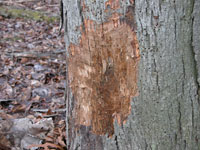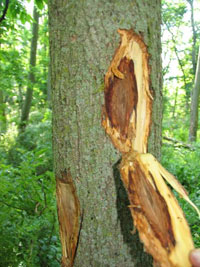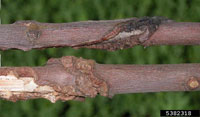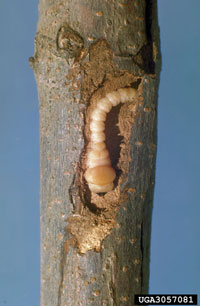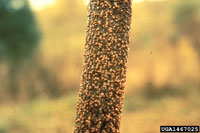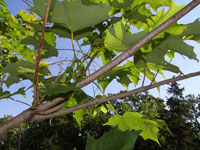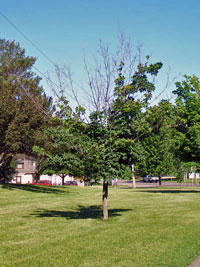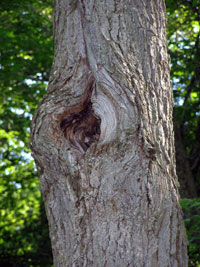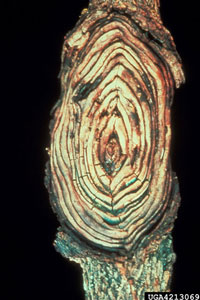Extension > Garden > Diagnose a problem > What's wrong with my plant? > Deciduous Trees > Hickory > Cracks or sunken areas of trunk or branches
Hickory > Trunk/Branches > Cracks or sunken areas of trunk or branches
1 of 4
Hickory decline
Ceratocystis smalleyi and
Scolytus quadrispinosus
- Leaves are wilted or undersized, thin canopy with dead branches
- When bark is peeled back, numerous reddish brown oval cankers up to 1 ft. long can be seen
- Bark surface often shows no symptoms, occasionally cracking or dark sunken area can be seen
- Dark bleeding spots that appear in May or June indicate cankers below the bark
- Groups of young green shoots (sprouts) often form along the trunk; these wilt and die within a year
- Round 1/8th inch exit holes of hickory bark beetles on upper trunk
- Larval galleries often visible in discolored sapwood
- Trees can decline and die in as little as two years when beetle populations are high
- More information on Hickory decline
2 of 4
Flatheaded appletree borer
Chrysobothris femorata
- White froth usually oozes from cracks in bark
- Dead branches in crown of older trees
- Bark becomes sunken at site of injury; bark may crack later
- Injured areas become larger and deform with annual attacks
- Young and stressed trees are most at risk
- Larvae are cream-colored, flattened bodies, about 1 inch long
- Long tunnels under the bark girdle trees and cause structural weakness
- More information on Flatheaded appletree borer
3 of 4
Coral spot canker
Nectria cinnabarina
- Sunken dark brown area on branch that is often cracked or has a ridge at the edge
- Raised cushion-like bumps on affected branches, may be cream to orange or red, turn black with age
- Dead branches and twigs, often first observed in early spring
- Common on trees stressed by drought, recent transplant or other factors
- More information on Coral spot canker
4 of 4
Perennial nectria canker
Neonectria ditissima
- Early canker symptoms are small and difficult to see, usually a darkened, depressed area forms on smooth, young bark
- Sunken round to oval cankers with target shaped ridges of barkless wood on large branches or main trunk
- Small dark sunken areas on twigs that can girdle or kill the branch
- Red to reddish orange raised cushion like bumps can occasionally be seen on the edge of the canker
- More information on Perennial nectria canker




